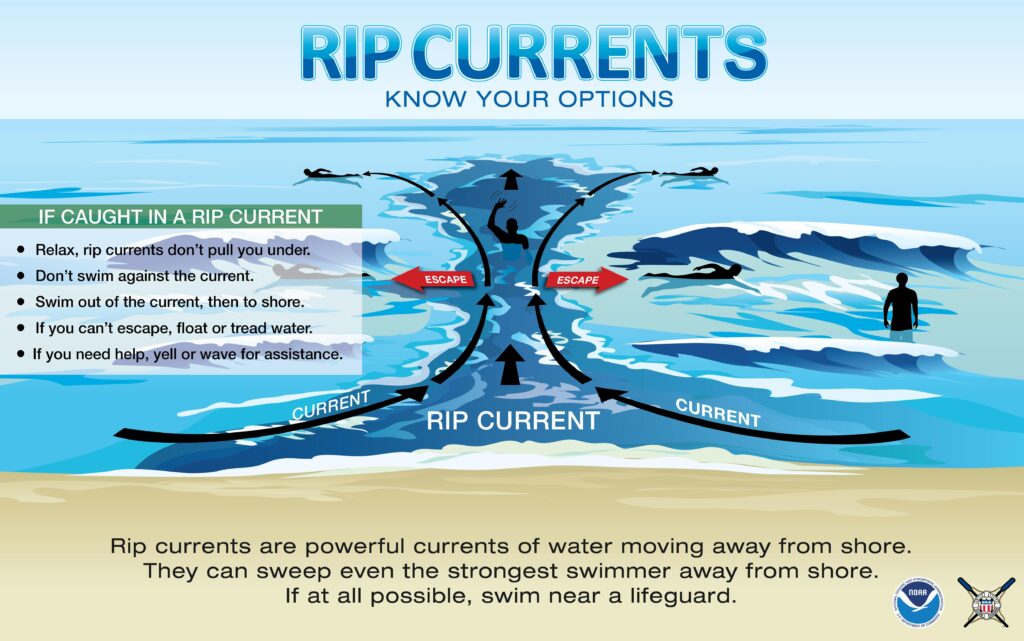As families prepare for beach vacations this summer, safety experts are issuing urgent warnings about the dangers of rip currents. Hoover Swim School officials are alerting beachgoers that these powerful water channels can pull swimmers out to sea in as little as 15 seconds, emphasizing the need for vigilance and awareness while in the water. With rip currents responsible for numerous rescues and fatalities each year, the swim school’s advisory serves as a timely reminder to prioritize safety amid rising beach attendance.
Rip Currents Pose Immediate Danger to Beachgoers Families Urged to Stay Vigilant Near Water
Rip currents can form quickly and without warning, pulling swimmers out to sea in mere seconds. Experts from the Hoover Swim School emphasize that even strong swimmers are vulnerable if caught unaware. Families planning beach trips are urged to recognize the signs of these powerful water flows and to educate children on safe swimming practices. Beachgoers should watch for discolored water, foamy or choppy areas, and a noticeable break in incoming wave patterns – all common indicators of rip currents.
To stay safe, experts recommend following simple yet effective precautions:
- Swim near lifeguards: Always choose beaches with active lifeguard stations and follow their instructions.
- Never swim alone: Keeping a buddy system helps ensure immediate help if trouble arises.
- Learn to react: Instead of fighting the pull, swim parallel to the shore to escape the current before heading back to land.
| Signs of a Rip Current | What to Do |
|---|---|
| Discolored or muddy water | Avoid swimming in that area |
| Choppy, foamy water breaking oddly | Stay close to shore and alert others |
| Strong current moving away from shore | Swim parallel to shore, don’t fight current |
Hoover Swim School Experts Explain How Rip Currents Form and What Swimmers Should Watch For
Rip currents develop when waves break strongly in some locations and weakly in others, causing a narrow, powerful channel of water to flow away from the shore. Hoover Swim School experts emphasize that these currents can form in as little as 15 seconds, making them particularly dangerous for unsuspecting swimmers and families enjoying a day at the beach. Recognizing the signs of an active rip current is crucial-look for areas where the water appears to be choppier or darker, where foam and debris move steadily seaward, or where the surface looks unusually calm between breaking waves.
To stay safe, swimmers should always:
- Swim near a lifeguard and ask about local conditions before entering the water.
- Avoid swimming alone-never underestimate the ocean’s power.
- Watch for visual cues such as differences in water color or unusual wave patterns indicating currents.
- Remain calm if caught in a rip current, and swim parallel to the shore instead of directly against the current.
| Rip Current Warning Signs | What to Do |
|---|---|
| Water darker or murky | Stay clear and alert lifeguards |
| Foam or debris moving seaward | Don’t fight the current, swim sideways |
| Breaks in the wave pattern | Heed local warnings, swim with caution |
Essential Safety Tips for Parents Traveling to the Beach Teaching Children How to Respond in Rip Currents
When enjoying a day at the beach, understanding the dangers posed by rip currents is crucial for parents and children alike. Rip currents can form suddenly and pull swimmers away from shore within seconds, making quick reactions essential. Parents should teach their children to stay calm if caught in a rip current and to avoid swimming directly against the flow, which only exhausts the swimmer. Instead, they should swim parallel to the shore until free from the current before making their way back to the beach. Equipping children and family members with this knowledge can significantly reduce risk and improve confidence in emergency situations.
Practical drills and discussions before the trip can reinforce these safety lessons. Consider reviewing signs of rip currents such as:
- Choppy or turbulent water patches differing from surrounding areas
- A noticeable difference in water color, often murkier or foamy
- Debris or seaweed moving steadily seaward
Additionally, beachgoers should always swim near lifeguard zones and never underestimate the ocean’s power. Below is a quick reference table to help families recognize and react appropriately:
| Rip Current Sign | What to Do | What NOT to Do |
|---|---|---|
| Foamy, churning water | Swim parallel to shore to escape current | Swim against the current toward shore |
| Water moving seaward faster than surrounding | Float or tread water if tired, signal for help | Panic or thrash violently |
| Dark gap or channel in waves | Alert an adult or lifeguard immediately | Enter the water if unsure about conditions |
Final Thoughts
As summer travel plans take families to beaches across the region, experts at Hoover Swim School urge caution and awareness of rip currents – powerful, fast-moving channels of water that can pull even strong swimmers out to sea in as little as 15 seconds. Understanding the dangers and knowing how to react can save lives. Authorities encourage beachgoers to remain vigilant, swim near lifeguards, and educate children on water safety to ensure a safe and enjoyable experience by the shore.





